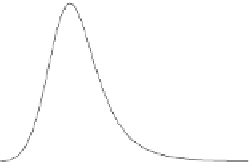Geoscience Reference
In-Depth Information
1 . 0
0 . 4
S
e
q
0 . 5
0 . 2
0
0
5 0
1 0 0
0
5 0
1 0 0
H ( c m )
H ( c m )
S
e
1 . 0
S
e
( c m
−
1
)
3 0 0
0 . 5
2 0 0
1 0 0
0
0
5 0
1 0 0
0
5 0
1 0 0
R (
m )
R (
m )
μ
μ
Fig. 8.11 Illustration of the successive coordinate transformations to derive the effective pore size density
function from the soil water characteristic. First, the water content is normalized to
S
e
; next, the
negative pore water pressure is transformed into the equivalent pore radius
R
by Laplace's equation;
finally, the density function is obtained from the pore radius distribution as
s
e
=
dS
e
/
dR
. The soil
water characteristic of this example was obtained during drainage of a fine sand.
θ/θ
0
) may be considered an index of the fraction
of the total pore volume, that is occupied by pores smaller than
R
.
To avoid the limitations of the capillary model in the range of lower water contents,
where other water retention forces are predominant, in this context it is convenient to
use a linear transformation, defining an effective saturation,
=
words, the degree of saturation
S
(
θ
−
θ
r
θ
0
−
θ
r
=
S
−
S
r
S
e
=
(8.6)
1
−
S
r
θ
0
is the water content at atmospheric pressure, i.e. at
H
=
where
0; the subscript r
refers to the residual water content or residual degree of saturation, which is mainly
a normalizing parameter but which may also be visualized as the moisture present in
dead end pores or otherwise so strongly held that it is unavailable for flow. The effective
pore size density
s
e
=
dR
can be obtained by determining the slope of
S
e
(
R
)asa
function of
R
. Figure 8.11 illustrates how such effective pore size distribution and density
functions can be obtained from the soil water characteristic by means of Equations (8.5)
and (8.6).
This approach to obtain a pore-size distribution probably dates back to the work of
Donat (1937), who used his results to characterize the structure and stability of soils.
Similar early studies were also undertaken by Schofield (1938), Bradfield and Jamison
(1938), Leamer and Lutz (1940), Childs (1942), Russell (1941) and Feng and Browning
(1946). As discussed further in Section 8.3.4, this type of pore size distribution has also
dS
e
(
R
)
/
























































































